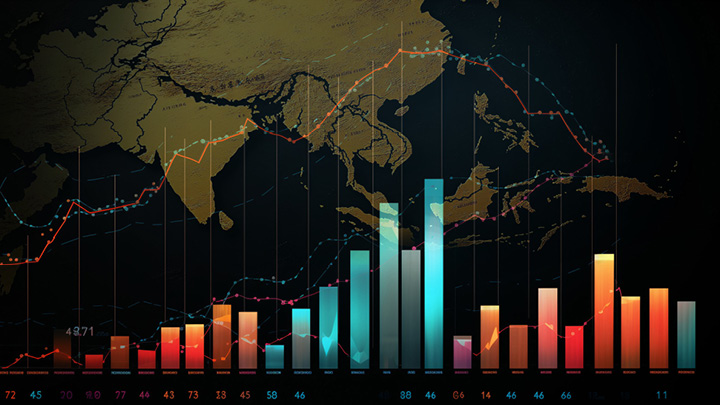As global central banks diversify their exposure to U.S. assets, the rising allocation to gold raises questions about the sensitivity of their reserves to gold prices and the consequent policy ramifications. While central banks are collectively on track to buy 1,000 metric tons for a fourth year in a row, we find that for most emerging markets, surging gold prices—not increased physical holdings—have been the main driver of rising gold reserves.1 Against this backdrop, we also observe that in the event of a sudden, sharp decline in gold prices, EM central bank reserve coverage and liquidity should still offer sufficient buffers against external risks.
Central bank reserve statistics point to growing gold allocations in recent quarters as the institutions have accumulated over 1,000t of gold in each of the last three years, up from the 400-500t average over the preceding decade.2 According to both market narratives and surveys, gold reserves are expected to increase over the next 12 months as central banks indicate a desire to allocate more to gold given growing concerns over trade, geopolitical risks, and the role of the U.S. dollar in the global financial system. This would increase their exposure to price drops if contextual factors (e.g., trade concerns) dissipate.
However, our analysis pours some cold water on the idea of a central bank gold rush. For most emerging market central banks that we analyzed, growth in reported gold holdings between 2022 and 2024 was predominantly the result of price increases as opposed to new purchases.
For context, Figure 1 illustrates the change in foreign assets, including gold, for 40 emerging market counties between 2022-2024 and the resulting liquidity ratio.3
Figure 1
Foreign Assets and Liquidity Ratios (%)
Source: Haver, Bloomberg, PGIM. As of July 2025.
Central banks usually hold gold as an inflation hedge or for diversification reasons. Uncertainty about the global trade framework and sanctions have also grown more salient for some central banks. Statistics on gold holdings are not readily available for some countries. However, anecdotal evidence suggests that the Russian and Chinese central banks have been the most intense buyers as they sought to diversify away from dollar assets for both economic and geopolitical reasons. For other EMs, aside from idiosyncratic issues, geopolitical factors might play a smaller role, and they might prefer more liquid assets (Figure 2).
Figure 2
Changes in Foreign Assets (%)
Source: Haver, Bloomberg, PGIM. As of July 2025.
Quantity versus Price Effects
To distinguish between the valuation effect and the change in physical bullion holdings, we first carried out a statistical analysis of the increase in gold reserves from end-2022 to end-2024. Figure 3 shows the respective contributions of changes in gold quantity and price to percentage changes in the value of gold holdings.
Figure 3
Gold Holdings Split Between Quantity and Price Effects (%)
Source: Haver, PGIM. As of July 2025.
As observed, almost all countries analysed grew their gold reserves. However, it was the change in gold price (not bullion accumulation) that predominantly drove this increase. Among those analysed, Bolivia, Kazakhstan, Philippines, and Suriname reduced their bullion holdings but, due to the price effect, the value of gold holdings only fell for Bolivia.
The Impact of a Gold Price Shock
As central banks increasingly look to gold as a source of diversification, stability, and hedge against inflation, we find that rising prices have been the main driver of higher gold holdings among EM central banks. This raises questions about how a steep drop in gold prices may impact EM central bank reserves. This leads us to our second conclusion, which is that it would take an extreme price movement to negatively affect EM central bank liquidity and their ability to use reserves to reduce currency or external funding risks.
To determine how vulnerable these EM countries are to a sharp drop in gold prices, we conducted a comparative static analysis on end-2024 figures by simulating a 30% and 60% drop in the price of gold (Figure 4).
Figure 4
Impact of a Gold Price Shock on Liquidity
Source: Haver, Bloomberg, PGIM. As of July 2025.
We then extended our stress analysis to import coverage, i.e. to the number of months of imports covered by a central bank’s foreign assets. This ratio is usually calculated using liquid FX reserves; hence, our ratios are higher than in, say, IMF reports (since foreign assets are higher than its subset, FX reserves; Figure 5).
Figure 5
Import Coverage Ratio During Negative Gold Shock
Source: Haver, Bloomberg, PGIM. As of July 2025.
The key finding of this stylized exercise is that even under a more severe, negative gold price scenario, many central banks with the largest absolute declines in liquidity still maintain comfortable ratios on a relative basis. However, we must caveat our results as this calculation assumes central banks can sell their gold in a crisis and the value of other reserve assets does not decline meaningfully. EM central banks could resort to accumulating additional reserves through the usual means, including, but not limited to, absorbing FX inflows related to trade and investments or absorbing proceeds of FX issuance or emergency financing.
1 Reuters, “Central Banks on Track for 4th year of Massive Gold Purchases, Metals Focus Says,” June 5, 2025.
2 World Gold Council, “Central Bank Gold Reserves Survey 2025,” June 15, 2025.
3 We define liquidity ratio as the ratio between a central bank’s foreign assets and short-term external debt redemptions plus the financing needed to cover the current account deficit.
Source(s) of data (unless otherwise noted): PGIM Fixed Income, as of July 2025.
For Professional Investors only. Past performance is not a guarantee or a reliable indicator of future results and an investment could lose value. All investments involve risk, including the possible loss of capital.
PGIM Fixed Income operates primarily through PGIM, Inc., a registered investment adviser under the U.S. Investment Advisers Act of 1940, as amended, and a Prudential Financial, Inc. (“PFI”) company. Registration as a registered investment adviser does not imply a certain level or skill or training. PGIM Fixed Income is headquartered in Newark, New Jersey and also includes the following businesses globally: (i) the public fixed income unit within PGIM Limited, located in London; (ii) PGIM Netherlands B.V., located in Amsterdam; (iii) PGIM Japan Co., Ltd. (“PGIM Japan”), located in Tokyo; (iv) the public fixed income unit within PGIM (Hong Kong) Ltd. located in Hong Kong; and (v) the public fixed income unit within PGIM (Singapore) Pte. Ltd., located in Singapore (“PGIM Singapore”). PFI of the United States is not affiliated in any manner with Prudential plc, incorporated in the United Kingdom or with Prudential Assurance Company, a subsidiary of M&G plc, incorporated in the United Kingdom. Prudential, PGIM, their respective logos, and the Rock symbol are service marks of PFI and its related entities, registered in many jurisdictions worldwide.
These materials are for informational or educational purposes only. The information is not intended as investment advice and is not a recommendation about managing or investing assets. In providing these materials, PGIM is not acting as your fiduciary. PGIM Fixed Income as a general matter provides services to qualified institutions, financial intermediaries and institutional investors. Investors seeking information regarding their particular investment needs should contact their own financial professional.
These materials represent the views and opinions of the author(s) regarding the economic conditions, asset classes, securities, issuers or financial instruments referenced herein. Distribution of this information to any person other than the person to whom it was originally delivered and to such person’s advisers is unauthorized, and any reproduction of these materials, in whole or in part, or the divulgence of any of the contents hereof, without prior consent of PGIM Fixed Income is prohibited. Certain information contained herein has been obtained from sources that PGIM Fixed Income believes to be reliable as of the date presented; however, PGIM Fixed Income cannot guarantee the accuracy of such information, assure its completeness, or warrant such information will not be changed. The information contained herein is current as of the date of issuance (or such earlier date as referenced herein) and is subject to change without notice. PGIM Fixed Income has no obligation to update any or all of such information; nor do we make any express or implied warranties or representations as to the completeness or accuracy.
Any forecasts, estimates and certain information contained herein are based upon proprietary research and should not be interpreted as investment advice, as an offer or solicitation, nor as the purchase or sale of any financial instrument. Forecasts and estimates have certain inherent limitations, and unlike an actual performance record, do not reflect actual trading, liquidity constraints, fee. These materials are not intended as an offer or solicitation with respect to the purchase or sale of any security or other financial instrument or any investment management services and should not be used as the basis for any investment decision. PGIM Fixed Income and its affiliates may make investment decisions that are inconsistent with the recommendations or views expressed herein, including for proprietary accounts of PGIM Fixed Income or its affiliates.
Investing in the bond market is subject to risks, including market, interest rate, issuer, credit, inflation risk, and liquidity risk. The value of most bonds and bond strategies are impacted by changes in interest rates. Bonds and bond strategies with longer durations tend to be more sensitive and volatile than those with shorter durations; bond prices generally fall as interest rates rise, and low-interest rate environments increase this risk. Reductions in bond counterparty capacity may contribute to decreased market liquidity and increased price volatility. Bond investments may be worth more or less than the original cost when redeemed. Mortgage- and asset-backed securities may be sensitive to changes in interest rates, subject to early repayment risk, and while generally supported by a government, government agency or private guarantor, there is no assurance that the guarantor will meet its obligations. High yield, lower-rated securities involve greater risk than higher-rated securities; portfolios that invest in them may be subject to greater levels of credit and liquidity risk than portfolios that do not. Investing in foreign-denominated and/or -domiciled securities may involve heightened risk due to currency fluctuations, and economic and political risks, which may be enhanced in emerging markets. Currency rates may fluctuate significantly over short periods of time and may reduce the returns of a portfolio. Commodities contain heightened risk, including market, political, regulatory and natural conditions, and may not be suitable for all investors. Diversification does not ensure against loss.
In the United Kingdom, information is issued by PGIM Limited with registered office: Grand Buildings, 1-3 Strand, Trafalgar Square, London, WC2N 5HR.PGIM Limited is authorised and regulated by the Financial Conduct Authority (“FCA”) of the United Kingdom (Firm Reference Number 193418). In the European Economic Area (“EEA”), information is issued by PGIM Netherlands B.V., an entity authorised by the Autoriteit Financiële Markten (“AFM”) in the Netherlands and operating on the basis of a European passport. In certain EEA countries, information is, where permitted, presented by PGIM Limited in reliance of provisions, exemptions or licenses available to PGIM Limited including those available under temporary permission arrangements following the exit of the United Kingdom from the European Union. These materials are issued by PGIM Limited and/or PGIM Netherlands B.V. to persons who are professional clients as defined under the rules of the FCA and/or to persons who are professional clients as defined in the relevant local implementation of Directive 2014/65/EU (MiFID II). In Switzerland, information is issued by PGIM Limited, London, through its Representative Office in Zurich with registered office: Kappelergasse 14, CH-8001 Zurich, Switzerland. PGIM Limited, London, Representative Office in Zurich is authorised and regulated by the Swiss Financial Market Supervisory Authority FINMA and these materials are issued to persons who are professional or institutional clients within the meaning of Art.4 para 3 and 4 FinSA in Switzerland. In certain countries in Asia-Pacific, information is presented by PGIM (Singapore) Pte. Ltd., a regulated entity with the Monetary Authority of Singapore under a Capital Markets Services License to conduct fund management and an exempt financial adviser. In Japan, information is presented by PGIM Japan Co. Ltd., registered investment adviser with the Japanese Financial Services Agency. In South Korea, information is presented by PGIM, Inc., which is licensed to provide discretionary investment management services directly to South Korean investors. In Hong Kong, information is provided by PGIM (Hong Kong) Limited, a regulated entity with the Securities & Futures Commission in Hong Kong to professional investors as defined in Section 1 of Part 1 of Schedule 1 of the Securities and Futures Ordinance (Cap.571). In Australia, this information is presented by PGIM (Australia) Pty Ltd (“PGIM Australia”) for the general information of its “wholesale” customers (as defined in the Corporations Act 2001). PGIM Australia is a representative of PGIM Limited, which is exempt from the requirement to hold an Australian Financial Services License under the Australian Corporations Act 2001 in respect of financial services. PGIM Limited is exempt by virtue of its regulation by the FCA (Reg: 193418) under the laws of the United Kingdom and the application of ASIC Class Order 03/1099. The laws of the United Kingdom differ from Australian laws. In Canada, pursuant to the international adviser registration exemption in National Instrument 31-103, PGIM, Inc. is informing you that: (1) PGIM, Inc. is not registered in Canada and is advising you in reliance upon an exemption from the adviser registration requirement under National Instrument 31-103; (2) PGIM, Inc.’s jurisdiction of residence is New Jersey, U.S.A.; (3) there may be difficulty enforcing legal rights against PGIM, Inc. because it is resident outside of Canada and all or substantially all of its assets may be situated outside of Canada; and (4) the name and address of the agent for service of process of PGIM, Inc. in the applicable Provinces of Canada are as follows: in Québec: Borden Ladner Gervais LLP, 1000 de La Gauchetière Street West, Suite 900 Montréal, QC H3B 5H4; in British Columbia: Borden Ladner Gervais LLP, 1200 Waterfront Centre, 200 Burrard Street, Vancouver, BC V7X 1T2; in Ontario: Borden Ladner Gervais LLP, 22 Adelaide Street West, Suite 3400, Toronto, ON M5H 4E3; in Nova Scotia: Cox & Palmer, Q.C., 1100 Purdy’s Wharf Tower One, 1959 Upper Water Street, P.O. Box 2380 -Stn Central RPO, Halifax, NS B3J 3E5; in Alberta: Borden Ladner Gervais LLP, 530 Third Avenue S.W., Calgary, AB T2P R3.
© 2025 PFI and its related entities.
2025-6386
Collapse Section










